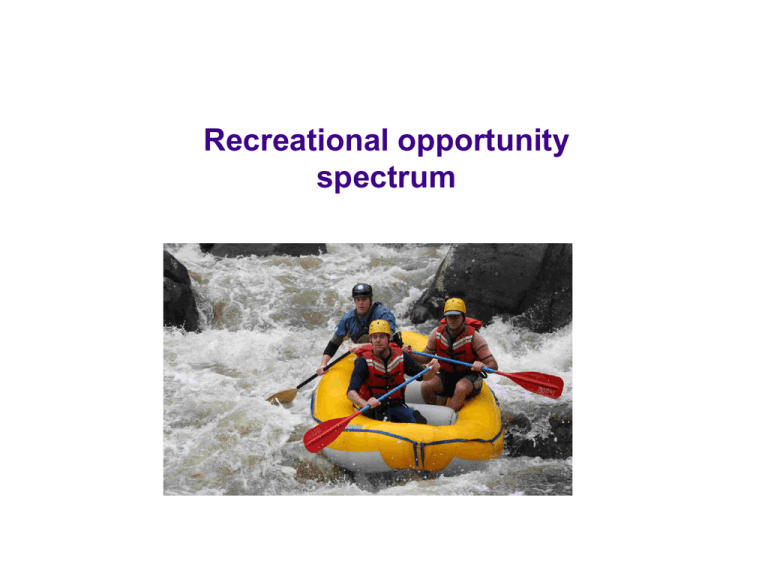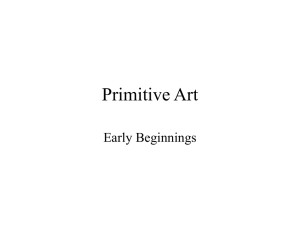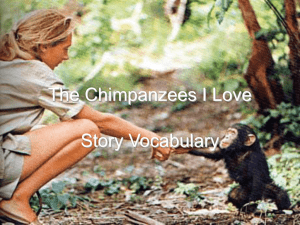Recreational opportunity spectrum analysis
advertisement

Recreational opportunity spectrum Recreational Opportunity Spectrum The basic idea behind ROS is that people should be provided with a range of recreation opportunities so that individual tastes can be appropriately accommodated. Goal of recreationist: “Have satisfying leisure experiences by participating in preferred activities in a favorable environmental settings” NOTE and CREDIT: the following information was adopted from the USDA USFS ROS Users guide and from Jason Siniscalchi, Ph.D. 2 Opportunities for achieving satisfying experiences.. Are a function of: natural elements (vegetation, landscape and scenery) areas controlled by land management agencies (developed sites, roads, regulations) 3 ROS The purpose of an Recreation Opportunity Spectrum Inventory is to identify, delineate, classify and record areas into recreation opportunity classes based on their current state of remoteness, naturalness and expected social experience. It is also to provide information about existing recreation opportunities to land use planners and resource managers to assist them in making decisions on appropriate land uses, resource development objectives and management prescriptions. 4 Goal of the resource manager Is to provide the opportunities to obtain the experiences by managing the natural setting and the activities within it. Challenges: While recreation must have a physical base of land or water, the product (recreation experience) is a personal phenomenon. 5 6 ROS six class spectrum Recreation Opportunity Spectrum Primitive SemiSemiRoaded primitive primitive Natural Non Motorized motorized Rural Urban For the resource manager and the recreationist, recreation opportunities can be expressed in terms of three principal components: Activities Setting Experience 7 Activities Recreation Opportunity Spectrum Primitive SemiSemiRoaded primitive primitive Natural Non Motorized motorized Rural Urban Land based Hunting Camping RV camping Resort lodging Bed and breakfast Bus touring Water based Fly Fishing Canoeing Waterskiing Sailing Boat Ferries Tour boat Snow based Snowshoeing Xcountry skiing Downhill skiing Snowmobiling Sledding Ice skating 8 Experience Recreation Opportunity Spectrum Primitive SemiSemiRoaded primitive primitive Natural Non Motorized motorized Rural Urban Isolation Highest probability Mostly high moderate Just as likely to see people Likely to see groups Groups are prevalent Interaction with nature Very close mostly close close Not as important some Must make an effort for it to happen Amt of challenge or risk High degree present some some Have to search it out Mostly just a spectator 9 Setting (GIS can be used here!!!) Recreation Opportunity Spectrum Primitive SemiSemiRoaded primitive primitive Natural Non Motorized motorized Rural Urban Remoteness All natural Mostly natural Mostly natural Evidence of man’s influence Substantial modified Mostly altered Size Large Moderate Moderate Moderate to smaller Smaller Varies Evidence of humans Don’t see many others Low but evident Others evident Moderate Moderate to high predominant 10 Mapping of areas currently providing recreation opportunities W h e r e G I S C a n Setting Component Mapping Criteria Physical Remoteness Size Evidence of humans Social User density Managerial Managerial regimentation and noticeability H e l p 11 Remoteness Primitive SemiSemiRoaded primitive primitive Natural Non Motorized motorized Rural Urban An area designated at least 3 miles from all roads, railroads or trails with motorized use An area designated at least ½ mile but not further than 3 miles from all roads, railroads or trails with motorized use No distance criteria No distance criteria An area within ½ mile of primitive roads or trails used by motor vehicles; but not closer than ½ mile from better than primitive roads An area designated within ½ mile from better than primitive roads and railroads 12 Tucker County example primitive roads and railroads 13 Tucker County example All roads, railroads and trails 14 Tucker County example Distance from primitive roads and railroads 15 Tucker County example Distance from All roads, railroads and trails 16 Remoteness Primitive SemiSemiRoaded primitive primitive Natural Non Motorized motorized Rural Urban An area designated at least 3 miles from all roads, railroads or trails with motorized use An area designated at least ½ mile but not further than 3 miles from all roads, railroads or trails with motorized use No distance criteria No distance criteria An area within ½ mile of primitive roads or trails used by motor vehicles; but not closer than ½ mile from better than primitive roads An area designated within ½ mile from better than primitive roads and railroads Using these to reclass the distance grids… 17 Tucker County example Legend Primitive Semi-primitive non-motorized Semi-primitive motorized Roaded natural Rural / Urban 18 Mapping of areas currently providing recreation opportunities Setting Component Mapping Criteria Physical Remoteness Size Evidence of humans Social User density Managerial Managerial regimentation and noticeability 19 Size Primitive SemiSemiRoaded primitive primitive Natural Non Motorized motorized Rural Urban 5,000 acres 2,500 acres No size criteria No size criteria 2,500 acres No size criteria Using these cutoffs to evaluate our remoteness by size… 20 Tucker County example Legend Primitive Semi-primitive non-motorized Semi-primitive motorized Roaded natural Rural / Urban Areas under 2,500 acres 21 Tucker County example Legend Primitive Semi-primitive non-motorized Semi-primitive motorized Roaded natural Rural / Urban Areas between 2,500 and 5,000 acres 22 Tucker County example Legend Primitive Semi-primitive non-motorized Semi-primitive motorized Roaded natural Rural / Urban Areas 5,000 acres or larger 23 Tucker County example Remoteness adjusted for size (must be at least 2,500 acres in this example) Legend Primitive Semi-primitive non-motorized Semi-primitive motorized Roaded natural Rural / Urban 24 Mapping of areas currently providing recreation opportunities Setting Component Mapping Criteria Physical Remoteness Size Evidence of humans Social User density Managerial Managerial regimentation and noticeability 25 Evidence of humans Primitive SemiSemiRoaded primitive primitive Natural Non Motorized motorized Rural Urban Setting is an unmodified natural environment Setting may have subtle modification s that are noticeable but not draw the attention Setting is culturally modified and dominates Setting is dominated by alterations Structures are very rare Structures are isolated Setting has moderate alterations that draw attention Structures are isoloated Easily noticed alterations Structures are generally scattered Public ownership Using these to adjust our mapped remoteness… Structures are readily apparent Private land ownership Structures are dominant Developed areas 26 Tucker County example Legend Public ownership Private ownership Developed areas Evidence of humans 27 Tucker County example Final Physical Setting component of the recreational opportunity spectrum Legend Primitive Semi-primitive non-motorized Semi-primitive motorized Roaded natural Rural 28 Urban Tucker County example Final Physical Setting component of the ROS compared to existing managed recreation lands Legend Blackwater Falls State Park Canaan Valley NWR Canaan Valley State Park Dolly Sods Wilderness Fairfax Stone State Park Fernow Experimental Forest Monongahela Nat. Forest Otter Creek Wilderness Legend Primitive Semi-primitive non-motorized Semi-primitive motorized Roaded natural Rural Urban 29 Mapping of areas currently providing recreation opportunities Setting Component Mapping Criteria Physical Remoteness We Used GIS Legend Semi-primitive non-motorized Semi-primitive motorized Roaded natural Rural Urban More subjec tive Size Primitive Evidence of humans Social User density Managerial Managerial regimentation and noticeability 30 Social Setting Criteria Primitive SemiSemiRoaded primitive primitive Natural Non Motorized motorized Rural Urban Usually has less than 6 parties per day encountered on trails and less than 3 parties visible at all campsites Usually 6-15 parties per day encountered on trails and 6 or less visible at campsites Frequency of contact is moderate to high in developed sites, on roads and trails and water surfaces moderate away from developed sites Large numbers of users onsite and in nearby areas Low to moderate contact frequency Frequency of contact is moderate to high on roads, low to moderate on trails and away from roads 31 Managerial Setting Criteria Primitive Semiprimitive Non motorized Semiprimitive Motorized Roaded Natural On-site regimentation is low with controls off site On-site regimentation and controls present but subtle On-site regimentation and controls present but subtle On-site regimentation and controls are noticeable but harmonize with the natural environment Rural Regimentation and controls obvious and numerous, largely in harmony with the man-made environment Urban Regimentation and controls obvious and numerous 32 Other components outside of the setting criteria: Class Attractiveness for each ROS Variety Outstanding features Special areas 33 Other components outside of the setting criteria: Activity Opportunities Existing activities Potential activities Activity criteria 34 Other components outside of the setting criteria: Recreation Developments Existing developments Legend Blackwater Falls State Park Canaan Valley NWR Canaan Valley State Park Dolly Sods Wilderness Fairfax Stone State Park Fernow Experimental Forest Monongahela Nat. Forest Otter Creek Wilderness Potential developments “Diff between ROS and existing” Legend Primitive Semi-primitive non-motorized Semi-primitive motorized Roaded natural Rural Urban 35 Other components outside of the setting criteria: Capacity by ROS class Land type Vegetation Social Other (access, length of season, pattern of use, etc) 36 GIS and recreation / tourism references McAdam, D. 1999. The Value and Scope of Geographic Information Systems in Tourism Management. Journal of Sustainable Tourism 7(1):77-92 Tarrant, M.A. and H. K. Cordell. 1999. Environmental Justice and the Spatial Distribution of Outdoor Recreation Sites: an Application of GIS. Journal of Leisure Research 31(1):18-34. Rogers, S. E. 1993. Current Research in Areas and Facilities. Park and Recreation 28(12):22-25. Olivieri, S. G. 1995. An Investigation of Recreational Facility Planning Decisions Comparing Existing Facility Locations with Decisions Based on Use of a Geographic Information System. PhD Dissertation. Texas A&M University. Wing, M. G. 1998. Using a Geographic Information System to Monitor Impacts in a Forested Setting. Corvallis: Oregon State University. Bahaire T. and M. Elliot White. 1999. The application of GIS in Sustainable Tourism Planning; A review. Journal of Sustainable Tourism 7(2): 159-174. Bishop I. D. and H. R. Gimblett. 2000. Management of Recreation Areas: GIS, Autonomous Agents, and Virtual Reality. Environment and Planning B: Planning and Design 27(3):423-435. 37





